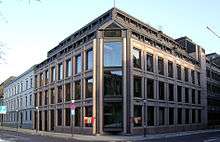Norges Bank
| Government agency | |
| Industry | Central bank |
| Founded | 14 June 1816 |
| Headquarters | Oslo, Norway |
Area served | Norway |
Key people | Øystein Olsen (Chairman) |
Number of employees | 590 (2010) |
| Parent | Ministry of Finance |
| Website | www.norges-bank.no |

Norges Bank / Noregs Bank is the central bank of Norway. Apart from having traditional central bank responsibilities such as financial stability and price stability, it manages The Government Pension Fund of Norway, a stabilization fund that may be the world's largest sovereign wealth fund.[1] The limited transparency of some SWFs makes it difficult to make accurate assessments of their assets under management.[2]
On 31 December 2010, the bank had 590 employees. All Executive Board appointments are made by the King of Norway, after a decision by the Council of State. The Chairman of the Executive Board, Øystein Olsen, who presides over the Bank, is also the acting Central Bank Governor. Both the Governor and the Deputy Governor make speaking appearances across the country on a number of occasions each year.
History
The history of the central bank of Norway can be easily traced back to 1816, when, two years after the separation from Denmark and the union with Sweden, Norges Bank was established by Act of the Storting (the Norwegian parliament) on 14 June. The bank then decided that the monetary unit was to be the speciedaler (rixdollar), divided into 120 skillings or five ort ("rigsort") of 24 skillings each.[3]
The Money Act of 17 April 1875 discontinued the terms daler and skilling, and it was decided that the monetary unit should be a krone, divided into 100 øre. This was done to prepare for Norway's entry, on 16 October that year, into the Scandinavian Monetary Union. This union had been established between Denmark and Sweden in 1873 on the recommendation of a joint commission (in which Norway participated) to establish a common Scandinavian coin based on gold. It meant that the other countries' coins were to be legal tender on the same basis as those struck at home. The union functioned until 1914; thereafter it lacked all practical significance, but was not formally abolished until 1972.[3]
On 1 January 1897 the seat of Norges Bank was moved to Kristiania (Oslo), and in 1906 a new headquarters building on Bankplassen was opened - for 80 employees including the workers in the banknote printing plant.[3]
During the second world war, the seat of Norges Bank was temporarily moved to London in 1940, in that the Norwegian government-in-exile established a new board. The bank's gold reserves were evacuated via Åndalsnes, Molde and Tromsø to London, and from there to New York and Ottawa. This gold and the bank's other currency reserves were under the control of the London board. At the same time, the bank continued its operations in Norway under the direction of the Nazis until the war was over and the London board stepped down. A commission of inquiry after the war concluded that the Bank's Oslo management had taken a firm and correct attitude towards the Nazi authorities.[3] In 1962, the Mint Supervisory Authority and the Royal Mint were transferred from the state to Norges Bank.[3]
Norges Bank Investment Management
NBIM is a separate part of Norges Bank and is responsible for the operational management of the Government Pension Fund - Global. NBIM also manages Norges Bank's foreign exchange reserves. NBIM invests the fund's assets and the foreign exchange reserves in international equities and fixed income instruments, money market instruments and derivatives.
List of Central Bank Governors
- Karl Gether Bomhoff (1893–1920)
- Nicolai Rygg (1920–1946)
- Arnold C. Ræstad (head of the London branch 1940–1945)
- Gunnar Jahn (1946–1954)
- Erik Brofoss (1954–1970)
- Knut Getz Wold (1970–1985)
- Hermod Skånland (1985–1993)
- Torstein Moland (1994–1995)
- Kjell Storvik (1996–1998)
- Svein Gjedrem (1999–2010)
- Øystein Olsen (2011–present)
See also
References
External links
- Official site: Norges Bank (Norwegian)
- Official site: Norges Bank (English)
Coordinates: 59°54′31.07″N 10°44′36.66″E / 59.9086306°N 10.7435167°E
